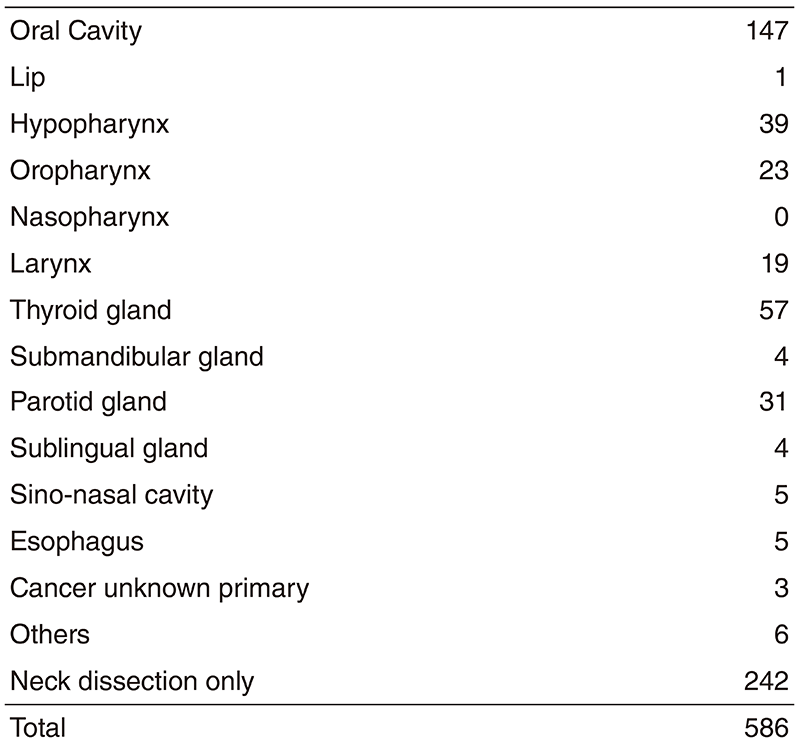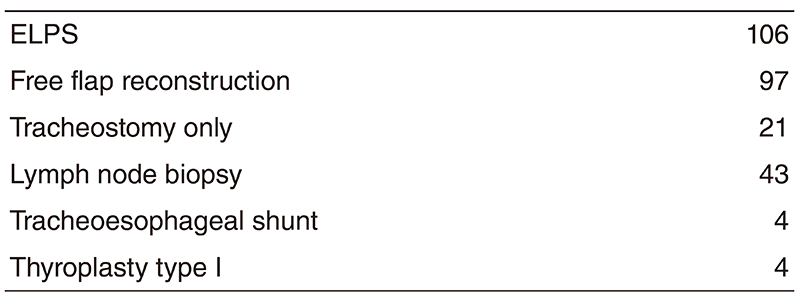Annual Report 2018
Department of Head and Neck Surgery
Ryuichi Hayashi, Takeshi Shinozaki, Toshifumi Tomioka, Wataru Okano, Masakazu Ikeda, Takahiko Nagaki, Yohei Morishita, Masao Adachi
Introduction
Surgical treatment of head and neck cancer must meet two contradictory requirements: (1) the resection volume must be sufficiently large to remove all cancer cells and (2) the resection volume should be sufficiently small to preserve important functions such as swallowing, speech, vision, and cosmetic appearance. The Department of Head and Neck Surgery resolves these conflicting requirements mainly by two distinct approaches: (1) conservative surgery and (2) extensive resection with microsurgical reconstruction. We have been developing various larynx-preserving operations since the establishment of the National Cancer Center (NCC). These procedures include a partial laryngectomy, which is indicated for T1/ T2 recurrent glottic carcinoma after radiotherapy. Another example of conservative surgery is partial laryngo-pharyngectomy with preservation of swallowing and voicing function for hypopharyngeal carcinoma. Recently, trans-oral resection for pharyngo-laryngeal cancer has been increasing as minimal invasive surgery. On the other hand, extensive resection with microsurgical reconstruction is designed to minimize loss of function following ablative surgery by employing the microsurgical transfer of various flaps.
Our team and what we do
The current treatment policy for head and neck cancer is multimodal therapy. To effectively implement available therapeutic modalities, four staff surgeons at our department work closely with plastic surgeons, radiotherapists, medical oncologists, pathologists, dentists, psychooncologists, and nurses. To facilitate regular communication among the members of this large team, several weekly conferences are conducted. The number of operations was 586 cases. One hundred and six cases all underwent endoscopic laryngo-pharyngeal surgery (ELPS) and 97 cases underwent free flap reconstruction (Tables 1, 2).
Table 1. Number of patients (April 2018~March 2019)
Table 2. Type of procedures (April 2018~March 2019)

Clinical trials
As a clinical study, a study on the development of diagnostic and therapeutic methods for superficial head and neck cancer based on the AMED Hayashi team (18ck0106226h0003) "National registry of superficial head and neck cancer" was advanced. This research was presented at ASCO2018 and gained a lot of attention. We believe that our procedure (ELPS) is more secure than the transoral robotic surgery (TORS) in Europe and the United States. In addition, a Phase III study of the "TOS-J trial" (Research representative: Ryuichi Hayashi, Phase II/III study of transoral surgery for superficial head and neck cancer in Japan) started in August. We plan to register 100 cases in the future.
On the other hand, three studies in the JCOG Head and Neck Cancer Group (Group Leader: Ryuichi Hayashi) also made progress. JCOG1008 (Phase II/III Trial of Postoperative Chemoradiotherapy Comparing 3-Weekly Cisplatin with Weekly Cisplatin in High-risk Patients with Squamous Cell Carcinoma of Head and Neck) has reached the planned enrollment target. JCOG1212 (Dose finding and confirmatory trial of superselective intraarterial infusion of cisplatin and concomitant radiotherapy for patients with locally advanced maxillary sinus cancer) has also reached the planned cohort enrollment target. A number of cases were also enrolled in JCOG1601 (Randomized phase III study to evaluate the value of omission of prophylactic neck dissection for stage I/II tongue cancer).
Education
One senior resident was recruited to our department in 2018. Two medical students and seven doctors visited our department for training. Our department was assigned as one of the observation centers of the International Federation of Head and Neck Oncologic Society (IFHNOS) fellowship program from 2014. We accepted four head and neck doctors from overseas countries.
Future prospects
Head and neck cancer treatment has entered a new era of multidisciplinary treatment, with the recognition of the importance of supportive care to complete the treatment, along with improvements in surgical techniques, technological innovation in radiation therapy, and development of pharmacotherapy. At the same time as building a smooth coordination system between related departments, we hope to promote the development of minimally invasive and function-preserving treatments such as transoral resection.
List of papers published in 2018
Journal
1. Matsuzuka T, Kiyota N, Mizusawa J, Akimoto T, Fujii M, Hasegawa Y, Iwae S, Monden N, Matsuura K, Onozawa Y, Hayashi R, Tahara M. Clinical impact of cachexia in unresectable locally advanced head and neck cancer: supplementary analysis of a phase II trial (JCOG0706-S2). Jpn J Clin Oncol, 49:37-41, 2019
2. Katsumata S, Aokage K, Nakasone S, Sakai T, Okada S, Miyoshi T, Tane K, Hayashi R, Ishii G, Tsuboi M. Radiologic Criteria in Predicting Pathologic Less Invasive Lung Cancer According to TNM 8th Edition. Clin Lung Cancer, 20:e163-e170, 2019
3. Tsushima N, Hayashi R, Shinozaki T, Tomioka T, Okano W, Ikeda M. The role of elective neck dissection for cT4aN0 glottic squamous cell carcinoma. Jpn J Clin Oncol, 49:525-528, 2019
4. Tomioka T, Beppu T, Fujii T, Ozawa T, Asakage T, Onitsuka T, Fujimoto Y, Matsuura K, Kawabata K, Hayashi R. Surgical management around the paratracheal area of hypopharyngeal cancer. Jpn J Clin Oncol, 2019
5. Hanai N, Asakage T, Kiyota N, Homma A, Hayashi R. Controversies in relation to neck management in N0 early oral tongue cancer. Jpn J Clin Oncol, 49:297-305, 2019
6. Okubo S, Gotohda N, Sugimoto M, Nomura S, Kobayashi S, Takahashi S, Hayashi R, Konishi M. Abdominal skin closure using subcuticular sutures prevents incisional surgical site infection in hepatopancreatobiliary surgery. Surgery, 164:251-256, 2018
7. Katsumata S, Aokage K, Miyoshi T, Tane K, Nakamura H, Sugano M, Kojima M, Fujii S, Kuwata T, Ochiai A, Hayashi R, Tsuboi M, Ishii G. Differences of tumor microenvironment between stage I lepidic-positive and lepidic-negative lung adenocarcinomas. J Thorac Cardiovasc Surg, 156:1679-1688.e2, 2018
8. Fukunaga Y, Higashino T, Oshima A, Hayashi R. Stripped Mesenteric Flap: A Novel Option for Preventing Anastomotic Leakage in Circumferential Pharyngeal Reconstruction. Plast Reconstr Surg Glob Open, 6:e2014, 2018
9. Kudo M, Gotohda N, Sugimoto M, Kobayashi T, Kojima M, Takahashi S, Konishi M, Hayashi R. Evaluation of liver function using gadolinium-ethoxybenzyl-diethylenetriamine pentaacetic acid enhanced magnetic resonance imaging based on a three-dimensional volumetric analysis system. Hepatol Int, 12:368-376, 2018
10. Tanaka K, Hanai N, Eba J, Mizusawa J, Asakage T, Homma A, Kiyota N, Fukuda H, Hayashi R. Randomized phase III study to evaluate the value of omission of prophylactic neck dissection for stage I/II tongue cancer: Japan Clinical Oncology Group study (JCOG1601, RESPOND). Jpn J Clin Oncol, 48:1105-1108, 2018
11. Sato T, Fujita T, Okada N, Fujiwara H, Kojima T, Hayashi R, Daiko H. Postoperative pulmonary complications and thoracocentesis associated with early versus late chest tube removal after thoracic esophagectomy with three-field dissection: a propensity score matching analysis. Surg Today, 48:1020-1030, 2018
